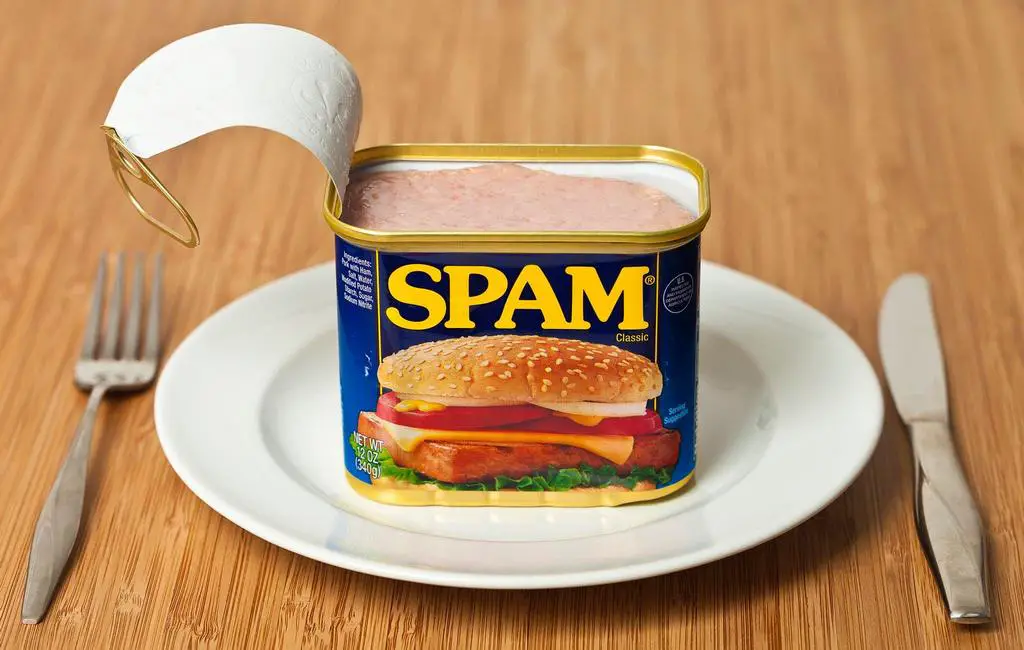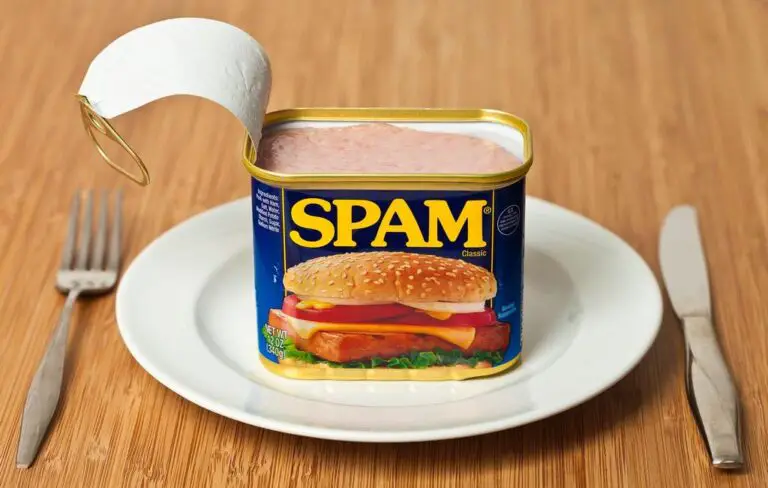How Long Can You Eat Spam After Opening? Spam Shelf Life Secrets

Spam, the iconic canned meat product, has been a pantry staple for generations. Whether you love it or are a bit more skeptical, you might wonder: How long can you safely enjoy Spam after you’ve opened the can?
In this article, we’ll uncover the secrets to Spam’s shelf life post-opening. We’ll provide you with all the information you need to savor this culinary classic. We’ll unveil the secrets of Spam’s shelf life and reveal the do’s and don’ts of enjoying this canned delicacy safely.
Whether you’re a long-time Spam aficionado or a curious newcomer, you’re about to uncover the secrets of Spam’s shelf life. This will ensure that your culinary adventures stay both delicious and safe. So, grab a can, open your mind (and your pantry), and let’s dive into the intriguing world of Spam’s longevity!
Understanding the Basics of Spam
When it comes to Spam, many know it as the iconic canned meat product that has been a pantry staple for generations. Spam only contains six ingredients, and the brand’s website lists them all. The ingredients are pork with ham, salt, water, modified potato starch, sugar, and sodium nitrite.
Spam is a processed meat, meaning it has been prepared to extend its shelf life for enhanced flavor and texture. Spam is convenient and easy to prepare when running short on time or with limited ingredients available. It can be eaten straight from the can and requires minimal preparation prior to consumption.
Spam has been made with the same recipe since 1937. The name “Spam” is not an acronym but rather a brand name created by the makers of the product. Spam was created to fill a huge need for inexpensive meat products during the Great Depression. Its popularity grew during World War II, due to its ability to be stored for long periods of time.
Today, there are 15 different Spam varieties, from Classic to Teriyaki to Jalapeño. Spam is a popular food item in Hawaii and the Philippines, where it is seen as a cultural symbol. It is commonly eaten with rice and a sunny-side-up egg for breakfast. It is prepared and used in a variety of ways, including being fried, caramelized, served with condiments, or in sandwiches.
It is commonly eaten with rice and a sunny-side-up egg for breakfast. It is prepared and used in a variety of ways. It can be fried, caramelized, served with condiments, or used in sandwiches.
How Long Can You Eat Spam After Opening?

So, let’s dive into the secrets of how long you can safely enjoy Spam after opening that can.
Here’s the scoop: Once that can opener does its job, the clock starts ticking. If you opt for the refrigerator as your storage spot, you can expect your opened Spam to stay good for approximately 7-10 days.
However, there’s a crucial caveat here. It must be kept in an airtight container or securely wrapped with plastic to fend off any unwanted exposure to the elements. If you find yourself unable to finish the opened can within that timeframe, worry not; the freezer can come to the rescue.
Frozen Spam can stay safe to eat for up to six months or more, although the quality may decline a bit over time. Yet, these timeframes are general guidelines. Several factors, like temperature, packaging, and the tightness of the seal, can affect the actual shelf life of your opened Spam.
For the visually inclined, here’s a helpful storage guide:
| Storage Method | Recommended Temperature | Shelf Life |
| Refrigerator | 34-40°F (1-4°C) | 7-10 days |
| Freezer | 0°F (-18°C) or lower | Up to 6 months or more |
As a bonus tip, remember to label your container with the date of opening to help keep track of freshness. And, if you need a refresher on whether your Spam has seen better days, watch out for signs like an off odor, strange texture, odd color, or an unpleasant taste. These are all indicators that it might be time to bid your Spam farewell.
| Read: Can You Eat Spam or Processed Meats on Carnivore Diet? |
Unveiling Spam’s Shelf Life
The shelf life of unopened Spam is quite impressive, often lasting for years. But once you open the can, the game changes. Here’s a breakdown of what you can expect:
- In the Fridge: When you open a can of Spam and refrigerate the remaining contents, it can stay good for up to 7-10 days. It’s crucial to keep it in an airtight container or cover it tightly with plastic wrap.
- In the Freezer: If you need more time, you can extend Spam’s life by freezing it. Frozen Spam can remain safe to eat for up to 6 months or even longer, though the quality may slightly deteriorate over time.
Keep in mind that these dates are just suggestions; the actual shelf life of opened Spam can change depending on a number of factors. Things like temperature, packaging, and how well you’ve maintained the seal on the remaining Spam can all impact its longevity.
Factors Affecting Spam’s Shelf Life
1. Storage Temperature
The temperature at which you store your opened Spam plays a significant role in how long it remains safe to eat. A consistent, cold environment like a refrigerator or freezer will help preserve it for a longer time.
2. Packaging
When you’re not planning to finish the opened Spam in one go, transferring it to an airtight container is crucial. Proper sealing, like a vacuum seal, minimizes exposure to air and helps prevent spoilage.
3. Exposure to Air
Exposure to air can lead to the development of bacteria and spoilage. Make sure you seal the Spam securely to limit its contact with oxygen.
4. Quality Degradation
Over time, the quality of Spam may deteriorate. While it may still be safe to eat, the texture and flavor can change.
Storing Opened Spam: Refrigerator and Room Temperature
The allure of Spam lies not only in its unique flavor but also in its remarkable shelf life, thanks to a meticulous canning process. However, once you’ve opened that can of meaty goodness, questions arise about whether it can be stored outside the refrigerator. Let’s explore the ins and outs of keeping an opened Spam fresh.
Refrigeration: The safest and most recommended way to store opened Spam is in the refrigerator. Place the remaining slices or chunks in an airtight container or a resealable plastic bag. By doing so, you help preserve the meat’s quality, prevent it from drying out, and keep it safe from bacterial growth. Properly refrigerated, opened Spam can last up to a week or even longer.
Room Temperature: While Spam is known for its longevity, leaving it at room temperature after opening is not advisable. Room temperature storage can lead to spoilage and bacterial growth, risking your health. It’s essential to prioritize food safety and refrigerate opened Spam to maintain its quality.
For a quick reference, see the table below:
| Storage Method | Recommendation |
| Refrigeration | Highly recommended |
| Room Temperature | Not recommended |
To enjoy your opened Spam safely and maximize its freshness, refrigeration is the way to go. It ensures you can continue savoring the delights of this canned meat while keeping food safety a priority.
Comparing the Shelf Life of Homemade Canned Meats with Commercial Spam
Canning meat is a time-honored tradition, whether done at home or mass-produced by commercial giants like Spam. Understanding the differences in shelf life between these two can provide valuable insights into the world of preserved meats.
Homemade Canned Meats
When you can meats in your kitchen, you control the ingredients, flavors, and preservation methods. Typically, home-canned meats have a shelf life of about 6 months to 1 year when stored in cool, dark, and dry conditions.
The exact longevity can vary depending on your canning techniques, the type of meat, and the recipe used. Properly sealed and stored canned meats can provide you with a tasty pantry staple. It’s more tailored to your taste preferences.
Commercial Spam
In contrast, commercial products like Spam are crafted with precision. They adhere to strict quality and safety standards. Spam boasts an impressive shelf life, thanks to its specialized canning process.
Unopened cans of Spam can stay fresh for up to 5 years or even longer. Once opened, if properly stored in the refrigerator, Spam can last for about a week or more. It’s this dedication to quality and consistency that makes Spam a reliable option for those seeking a long-lasting meat product.
Let’s summarize the key differences in the table below:
| Aspect | Homemade Canned Meats | Commercial Spam |
| Shelf Life (Unopened) | 6 months to 1 year, depending on method | Up to 5 years or longer |
| Shelf Life (Opened) | About 1 week or more in the | About 1 week or more when |
| refrigerator | properly refrigerated |
Both homemade canned meats and commercial Spam have their own unique advantages. While homemade canning allows for customization, Spam excels in its consistent longevity. Choosing between the two depends on your preferences and the convenience you seek in your culinary endeavors.
| Find out: Is There a Beef Version of Spam? |
Signs That Your Spam Has Gone Bad
While Spam typically has a long shelf life, it’s essential to be aware of the signs that indicate it might be time to say goodbye to your opened can. If you notice any of the following, it’s best to discard the Spam:
- Unpleasant Odor: If the Spam smells offor isr unpleasant, it’s a clear sign that it’s gone bad.
- Texture Changes: When Spam becomes mushy, slimy, or develops an unusual texture, it’s best to err on the side of caution and avoid consuming it.
- Odd Color: Any changes in color, particularly if it appears discolored or has spots of mold, are indicators of spoilage.
- Off Taste: If the Spam tastes different from what you’re used to, especially if it’s sour or bitter, it’s best to discard it.
Tips for Optimal Spam Storage
- Place opened Spam in an airtight container or resealable bag.
- Label the container with the date of opening to keep track of its freshness.
- Store it away from strong odors in the fridge or freezer to prevent flavor absorption.
- Thaw frozen Spam in the refrigerator for best results rather than at room temperature.
Extending the Shelf Life of Opened Spam
One of the great convenience foods in many households is canned meat like Spam. But once you crack open that can, how long can you really eat it for? The answer depends on how well you store it and if you follow a few key tips to extend its shelf life.
Let’s delve into some smart strategies for making your opened Spam last as long as possible.
1. Refrigeration: The first and most crucial step to prolong your opened Spam’s shelf life is to refrigerate it. Transfer the remaining slices or chunks into an airtight container or resealable plastic bag. Make sure they’re fully submerged in their own juices. This preserves the meat’s quality and prevents it from drying out or absorbing odors from your fridge. Properly stored, Spam can last in the refrigerator for up to a week or more.
2. Freezing: If you find yourself with an abundance of leftover Spam, consider freezing it. Wrap the individual slices or portions in plastic wrap or aluminum foil, and place them in a freezer-safe bag. When frozen, Spam can keep for several months, maintaining its taste and texture. To use frozen Spam, simply thaw it in the refrigerator or cook it directly from frozen – it’s remarkably versatile.
3. Vacuum Sealing: Investing in a vacuum sealer can be a game-changer for extending the shelf life of your opened Spam. Vacuum-sealed packs remove air. This significantly slows down the oxidation process that leads to spoilage. This method can preserve the meat’s quality for an extended period of time. It often exceeds the standard refrigerator or freezer storage times.
Use the table below for quick reference:
| Storage Method | Shelf Life |
| Refrigeration | Up to one week or longer |
| Freezing | Several months |
| Vacuum Sealing | Extended shelf life |
By adopting these savvy storage techniques, you can savor your beloved Spam for an extended period. This ensures it remains a delectable addition to your culinary repertoire.
| Also see: What Happens If You Eat Expired Spam? |
Final Thoughts
Spam is a versatile and long-lasting canned meat that can be enjoyed in various culinary creations. Understanding how to store it properly can help you make the most of your supply without compromising your safety.
Remember that the guidelines provided here are just that—guidelines. The true shelf life of your opened Spam depends on how well you adhere to storage recommendations. It also depends on the unique conditions of your storage space.
So, the next time you ponder how long you can eat Spam after opening, keep these tips in mind. You can fry it for breakfast, add it to a sandwich, or create a unique Spam dish. You can do so with confidence, knowing you’re making the most of this timeless classic.
FAQs on Expiration Date for Opened Spam
How can you tell if Spam has gone bad?
You can identify spoiled Spam through a change in color, texture, or the presence of an off-putting odor. Additionally, if there are any signs of bulging or rusting on the can, it’s best to discard it immediately.
Can you get sick from eating expired Spam?
Eating expired Spam can lead to food poisoning and various gastrointestinal issues. To avoid the health risks of eating spam, it’s crucial to adhere to the recommended expiration dates and storage guidelines for canned meats.
Are there any natural preservatives in Spam?
Yes, Spam includes natural preservatives like salt and sugar. They help inhibit bacterial growth and extend the shelf life of the product. These preservatives, along with the canning process, contribute to the longevity of Spam.
Is it safe to eat Spam past its expiration date?
Consuming Spam past its expiration date can pose health risks. It’s advisable to adhere to the expiration dates for optimal safety and quality of the product.
How does the taste of Spam change as it nears its expiration date?
As Spam approaches its expiration date, the flavor and aroma might turn sour or rancid. Texture changes might also occur, making it less appealing and potentially harmful if consumed.
Can the packaging of Spam affect its shelf life?
Proper packaging, especially in an airtight can, is crucial for maintaining the shelf life of Spam. Damaged or compromised packaging can lead to contamination, spoilage, and a shortened shelf-life.






